Business Law Assignment: Tort of Negligence and Consumer Protection
VerifiedAdded on 2023/04/04
|11
|2690
|326
Report
AI Summary
This business law assignment explores the concepts of negligence and consumer law in the context of product liability within the Australian legal framework. The report begins by analyzing a hypothetical case involving a defective baby cot, examining whether the consumers, Priya and Rahul, can successfully sue in tort of negligence. It delves into the elements of negligence, including duty of care, breach of duty, causation, and foreseeability, applying these principles to the provided scenario. The assignment then transitions to the Australian Consumer Law (ACL), specifically focusing on the rights and protections afforded to consumers against defective goods and misleading conduct. It examines relevant sections of the ACL concerning consumer guarantees, manufacturer liability, and the remedies available to consumers. The report concludes by determining the basis upon which Priya and Rahul could pursue legal action under the ACL, outlining the specific provisions that apply to their situation, and offering a concise overview of the legal principles at play.
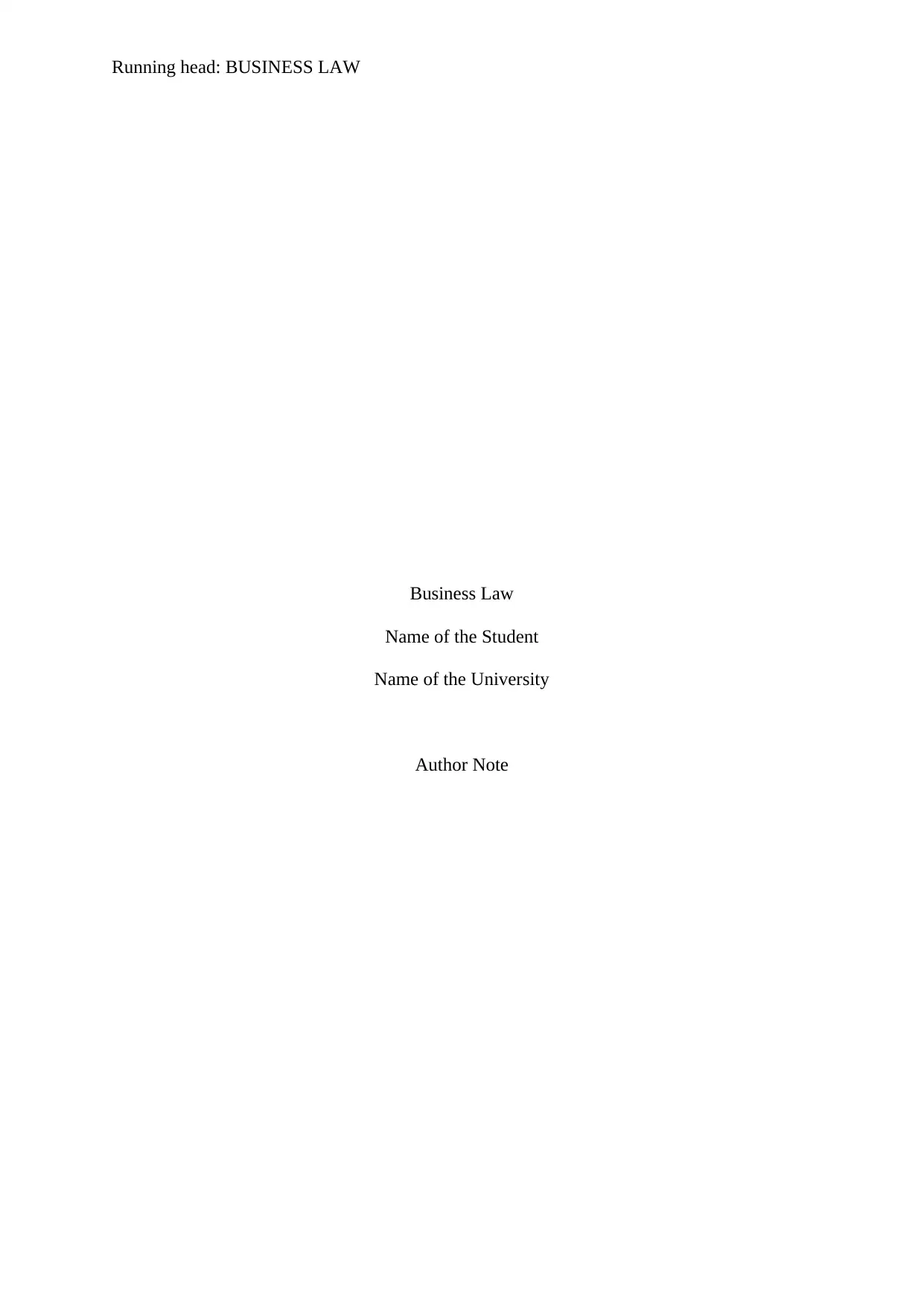
Running head: BUSINESS LAW
Business Law
Name of the Student
Name of the University
Author Note
Business Law
Name of the Student
Name of the University
Author Note
Paraphrase This Document
Need a fresh take? Get an instant paraphrase of this document with our AI Paraphraser
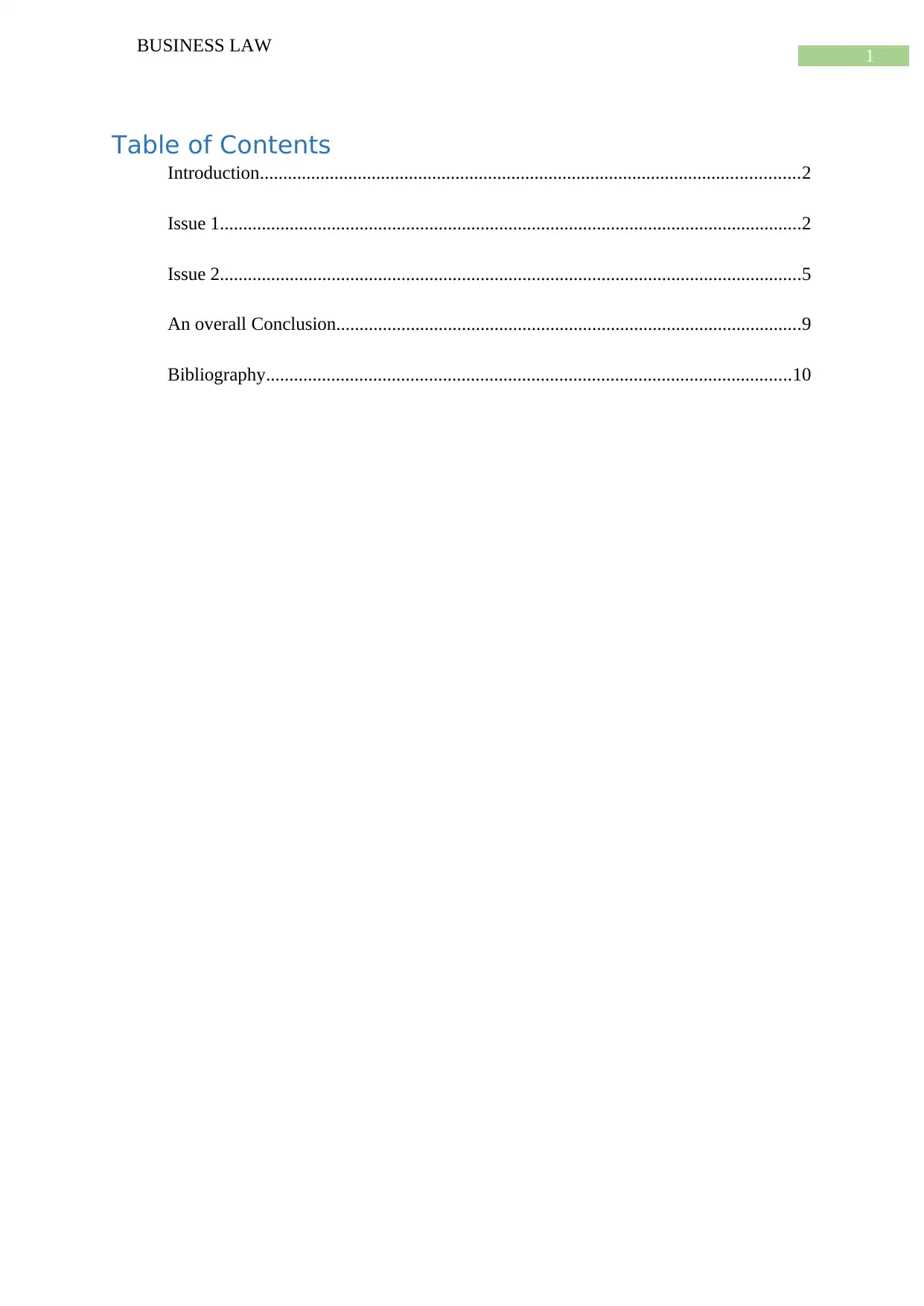
1
BUSINESS LAW
Table of Contents
Introduction....................................................................................................................2
Issue 1.............................................................................................................................2
Issue 2.............................................................................................................................5
An overall Conclusion....................................................................................................9
Bibliography.................................................................................................................10
BUSINESS LAW
Table of Contents
Introduction....................................................................................................................2
Issue 1.............................................................................................................................2
Issue 2.............................................................................................................................5
An overall Conclusion....................................................................................................9
Bibliography.................................................................................................................10
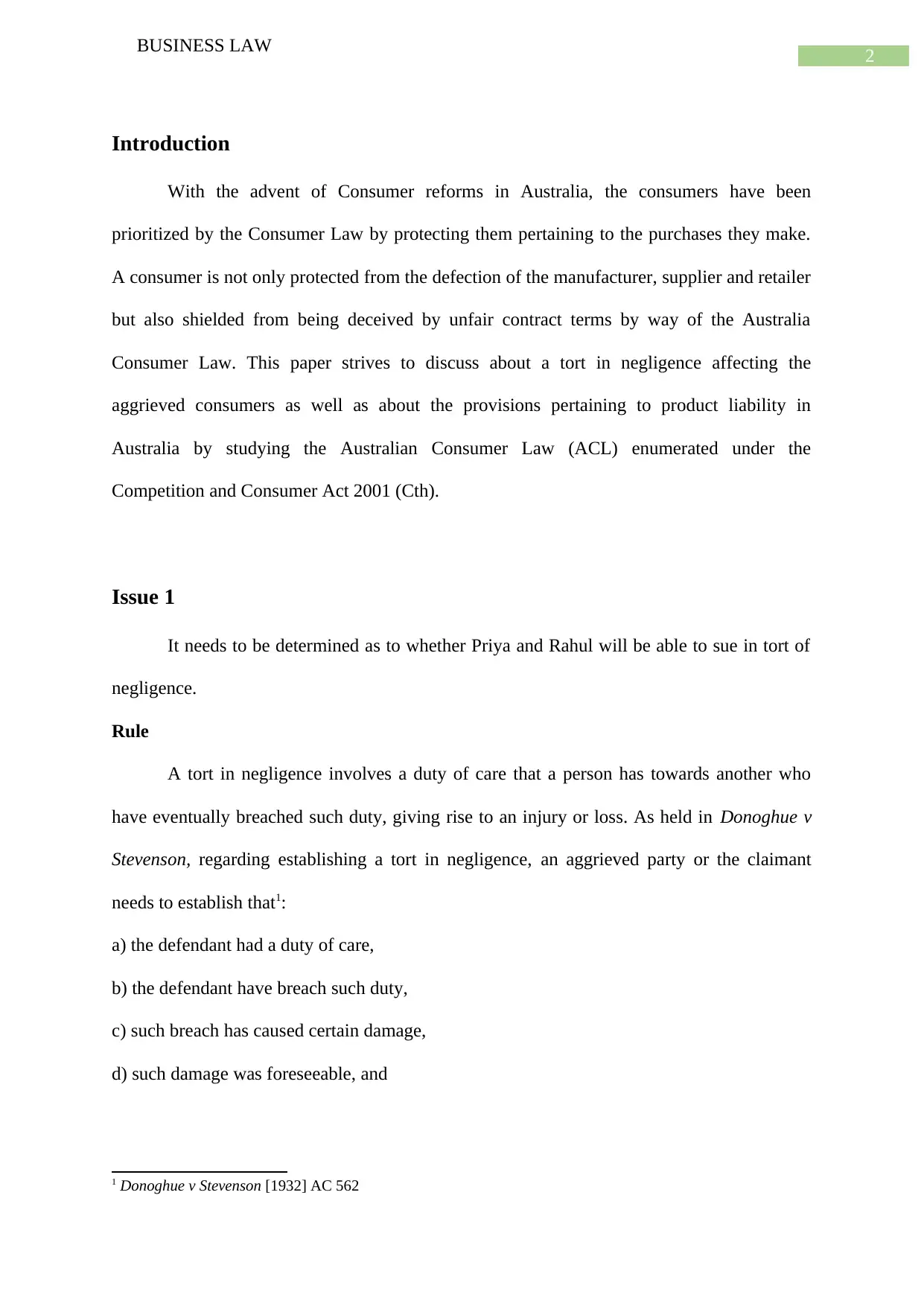
2
BUSINESS LAW
Introduction
With the advent of Consumer reforms in Australia, the consumers have been
prioritized by the Consumer Law by protecting them pertaining to the purchases they make.
A consumer is not only protected from the defection of the manufacturer, supplier and retailer
but also shielded from being deceived by unfair contract terms by way of the Australia
Consumer Law. This paper strives to discuss about a tort in negligence affecting the
aggrieved consumers as well as about the provisions pertaining to product liability in
Australia by studying the Australian Consumer Law (ACL) enumerated under the
Competition and Consumer Act 2001 (Cth).
Issue 1
It needs to be determined as to whether Priya and Rahul will be able to sue in tort of
negligence.
Rule
A tort in negligence involves a duty of care that a person has towards another who
have eventually breached such duty, giving rise to an injury or loss. As held in Donoghue v
Stevenson, regarding establishing a tort in negligence, an aggrieved party or the claimant
needs to establish that1:
a) the defendant had a duty of care,
b) the defendant have breach such duty,
c) such breach has caused certain damage,
d) such damage was foreseeable, and
1 Donoghue v Stevenson [1932] AC 562
BUSINESS LAW
Introduction
With the advent of Consumer reforms in Australia, the consumers have been
prioritized by the Consumer Law by protecting them pertaining to the purchases they make.
A consumer is not only protected from the defection of the manufacturer, supplier and retailer
but also shielded from being deceived by unfair contract terms by way of the Australia
Consumer Law. This paper strives to discuss about a tort in negligence affecting the
aggrieved consumers as well as about the provisions pertaining to product liability in
Australia by studying the Australian Consumer Law (ACL) enumerated under the
Competition and Consumer Act 2001 (Cth).
Issue 1
It needs to be determined as to whether Priya and Rahul will be able to sue in tort of
negligence.
Rule
A tort in negligence involves a duty of care that a person has towards another who
have eventually breached such duty, giving rise to an injury or loss. As held in Donoghue v
Stevenson, regarding establishing a tort in negligence, an aggrieved party or the claimant
needs to establish that1:
a) the defendant had a duty of care,
b) the defendant have breach such duty,
c) such breach has caused certain damage,
d) such damage was foreseeable, and
1 Donoghue v Stevenson [1932] AC 562
⊘ This is a preview!⊘
Do you want full access?
Subscribe today to unlock all pages.

Trusted by 1+ million students worldwide
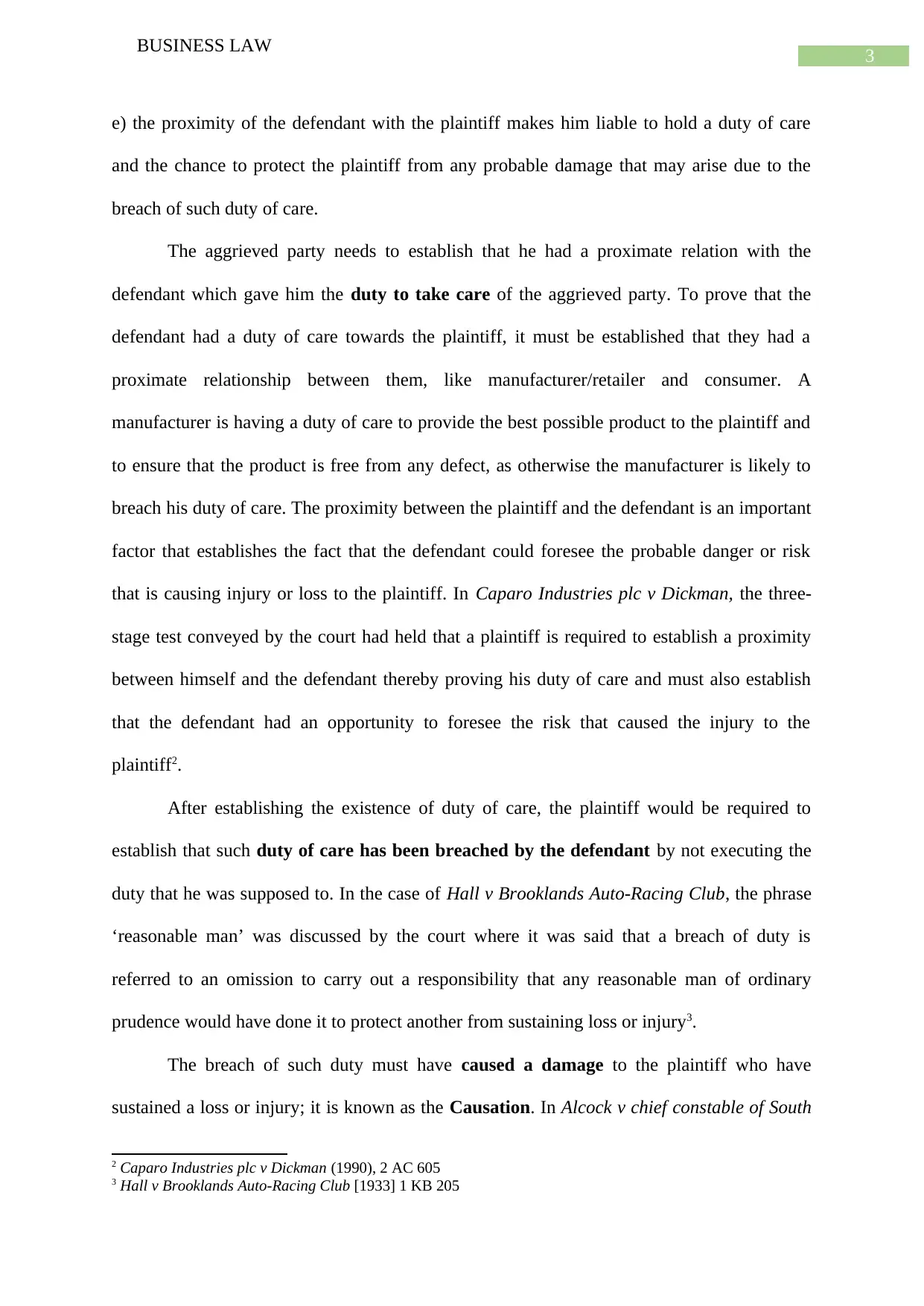
3
BUSINESS LAW
e) the proximity of the defendant with the plaintiff makes him liable to hold a duty of care
and the chance to protect the plaintiff from any probable damage that may arise due to the
breach of such duty of care.
The aggrieved party needs to establish that he had a proximate relation with the
defendant which gave him the duty to take care of the aggrieved party. To prove that the
defendant had a duty of care towards the plaintiff, it must be established that they had a
proximate relationship between them, like manufacturer/retailer and consumer. A
manufacturer is having a duty of care to provide the best possible product to the plaintiff and
to ensure that the product is free from any defect, as otherwise the manufacturer is likely to
breach his duty of care. The proximity between the plaintiff and the defendant is an important
factor that establishes the fact that the defendant could foresee the probable danger or risk
that is causing injury or loss to the plaintiff. In Caparo Industries plc v Dickman, the three-
stage test conveyed by the court had held that a plaintiff is required to establish a proximity
between himself and the defendant thereby proving his duty of care and must also establish
that the defendant had an opportunity to foresee the risk that caused the injury to the
plaintiff2.
After establishing the existence of duty of care, the plaintiff would be required to
establish that such duty of care has been breached by the defendant by not executing the
duty that he was supposed to. In the case of Hall v Brooklands Auto-Racing Club, the phrase
‘reasonable man’ was discussed by the court where it was said that a breach of duty is
referred to an omission to carry out a responsibility that any reasonable man of ordinary
prudence would have done it to protect another from sustaining loss or injury3.
The breach of such duty must have caused a damage to the plaintiff who have
sustained a loss or injury; it is known as the Causation. In Alcock v chief constable of South
2 Caparo Industries plc v Dickman (1990), 2 AC 605
3 Hall v Brooklands Auto-Racing Club [1933] 1 KB 205
BUSINESS LAW
e) the proximity of the defendant with the plaintiff makes him liable to hold a duty of care
and the chance to protect the plaintiff from any probable damage that may arise due to the
breach of such duty of care.
The aggrieved party needs to establish that he had a proximate relation with the
defendant which gave him the duty to take care of the aggrieved party. To prove that the
defendant had a duty of care towards the plaintiff, it must be established that they had a
proximate relationship between them, like manufacturer/retailer and consumer. A
manufacturer is having a duty of care to provide the best possible product to the plaintiff and
to ensure that the product is free from any defect, as otherwise the manufacturer is likely to
breach his duty of care. The proximity between the plaintiff and the defendant is an important
factor that establishes the fact that the defendant could foresee the probable danger or risk
that is causing injury or loss to the plaintiff. In Caparo Industries plc v Dickman, the three-
stage test conveyed by the court had held that a plaintiff is required to establish a proximity
between himself and the defendant thereby proving his duty of care and must also establish
that the defendant had an opportunity to foresee the risk that caused the injury to the
plaintiff2.
After establishing the existence of duty of care, the plaintiff would be required to
establish that such duty of care has been breached by the defendant by not executing the
duty that he was supposed to. In the case of Hall v Brooklands Auto-Racing Club, the phrase
‘reasonable man’ was discussed by the court where it was said that a breach of duty is
referred to an omission to carry out a responsibility that any reasonable man of ordinary
prudence would have done it to protect another from sustaining loss or injury3.
The breach of such duty must have caused a damage to the plaintiff who have
sustained a loss or injury; it is known as the Causation. In Alcock v chief constable of South
2 Caparo Industries plc v Dickman (1990), 2 AC 605
3 Hall v Brooklands Auto-Racing Club [1933] 1 KB 205
Paraphrase This Document
Need a fresh take? Get an instant paraphrase of this document with our AI Paraphraser
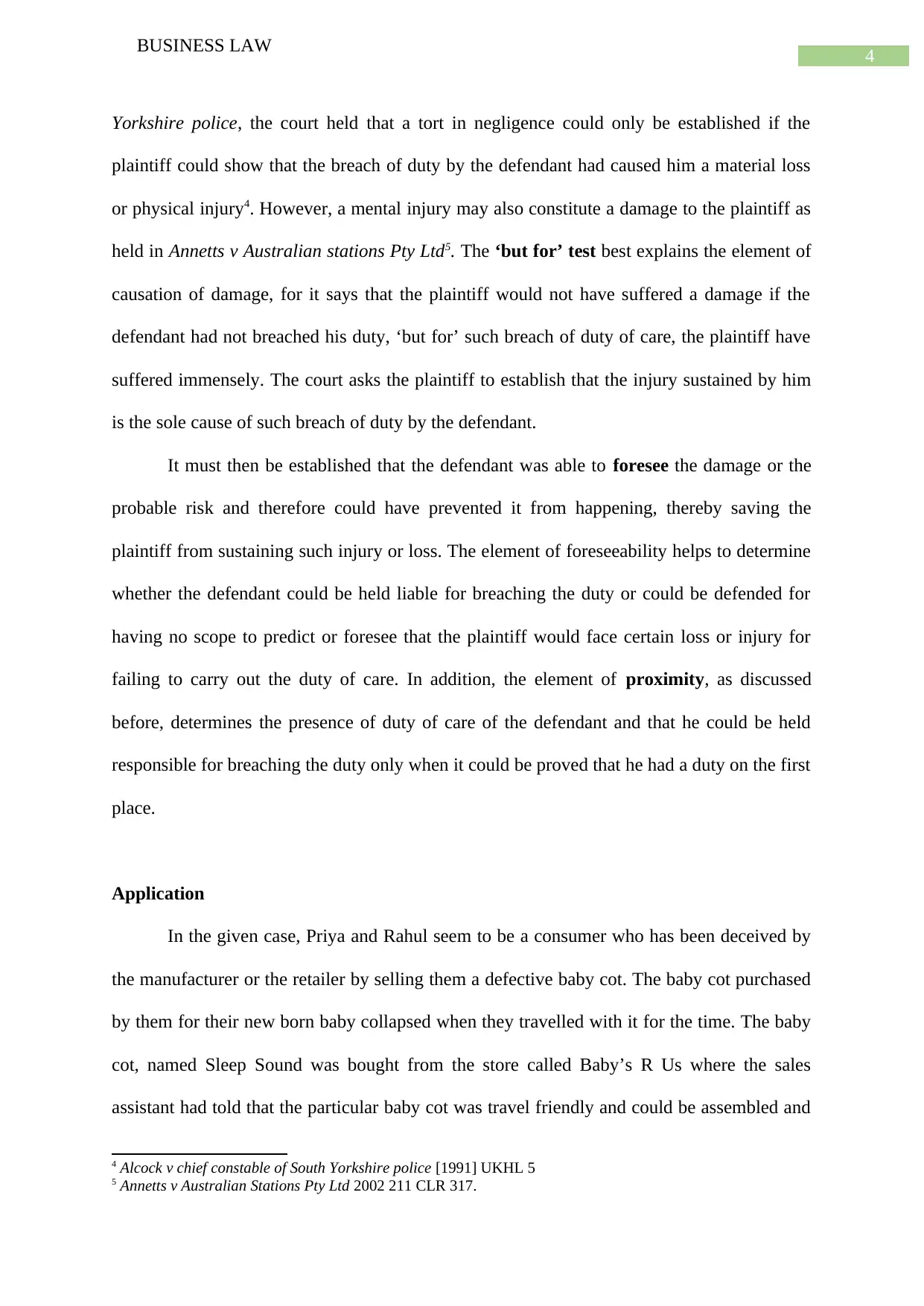
4
BUSINESS LAW
Yorkshire police, the court held that a tort in negligence could only be established if the
plaintiff could show that the breach of duty by the defendant had caused him a material loss
or physical injury4. However, a mental injury may also constitute a damage to the plaintiff as
held in Annetts v Australian stations Pty Ltd5. The ‘but for’ test best explains the element of
causation of damage, for it says that the plaintiff would not have suffered a damage if the
defendant had not breached his duty, ‘but for’ such breach of duty of care, the plaintiff have
suffered immensely. The court asks the plaintiff to establish that the injury sustained by him
is the sole cause of such breach of duty by the defendant.
It must then be established that the defendant was able to foresee the damage or the
probable risk and therefore could have prevented it from happening, thereby saving the
plaintiff from sustaining such injury or loss. The element of foreseeability helps to determine
whether the defendant could be held liable for breaching the duty or could be defended for
having no scope to predict or foresee that the plaintiff would face certain loss or injury for
failing to carry out the duty of care. In addition, the element of proximity, as discussed
before, determines the presence of duty of care of the defendant and that he could be held
responsible for breaching the duty only when it could be proved that he had a duty on the first
place.
Application
In the given case, Priya and Rahul seem to be a consumer who has been deceived by
the manufacturer or the retailer by selling them a defective baby cot. The baby cot purchased
by them for their new born baby collapsed when they travelled with it for the time. The baby
cot, named Sleep Sound was bought from the store called Baby’s R Us where the sales
assistant had told that the particular baby cot was travel friendly and could be assembled and
4 Alcock v chief constable of South Yorkshire police [1991] UKHL 5
5 Annetts v Australian Stations Pty Ltd 2002 211 CLR 317.
BUSINESS LAW
Yorkshire police, the court held that a tort in negligence could only be established if the
plaintiff could show that the breach of duty by the defendant had caused him a material loss
or physical injury4. However, a mental injury may also constitute a damage to the plaintiff as
held in Annetts v Australian stations Pty Ltd5. The ‘but for’ test best explains the element of
causation of damage, for it says that the plaintiff would not have suffered a damage if the
defendant had not breached his duty, ‘but for’ such breach of duty of care, the plaintiff have
suffered immensely. The court asks the plaintiff to establish that the injury sustained by him
is the sole cause of such breach of duty by the defendant.
It must then be established that the defendant was able to foresee the damage or the
probable risk and therefore could have prevented it from happening, thereby saving the
plaintiff from sustaining such injury or loss. The element of foreseeability helps to determine
whether the defendant could be held liable for breaching the duty or could be defended for
having no scope to predict or foresee that the plaintiff would face certain loss or injury for
failing to carry out the duty of care. In addition, the element of proximity, as discussed
before, determines the presence of duty of care of the defendant and that he could be held
responsible for breaching the duty only when it could be proved that he had a duty on the first
place.
Application
In the given case, Priya and Rahul seem to be a consumer who has been deceived by
the manufacturer or the retailer by selling them a defective baby cot. The baby cot purchased
by them for their new born baby collapsed when they travelled with it for the time. The baby
cot, named Sleep Sound was bought from the store called Baby’s R Us where the sales
assistant had told that the particular baby cot was travel friendly and could be assembled and
4 Alcock v chief constable of South Yorkshire police [1991] UKHL 5
5 Annetts v Australian Stations Pty Ltd 2002 211 CLR 317.
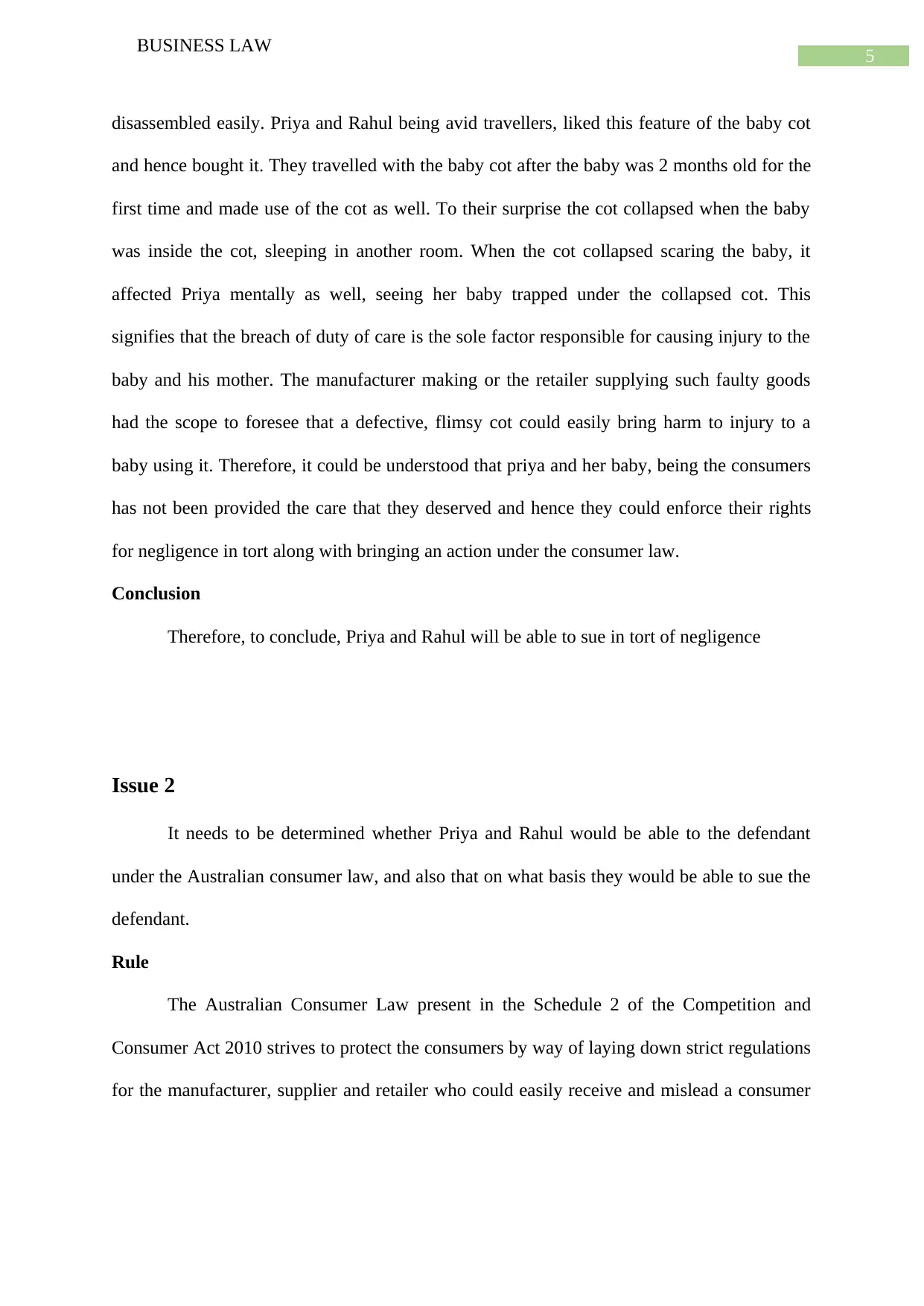
5
BUSINESS LAW
disassembled easily. Priya and Rahul being avid travellers, liked this feature of the baby cot
and hence bought it. They travelled with the baby cot after the baby was 2 months old for the
first time and made use of the cot as well. To their surprise the cot collapsed when the baby
was inside the cot, sleeping in another room. When the cot collapsed scaring the baby, it
affected Priya mentally as well, seeing her baby trapped under the collapsed cot. This
signifies that the breach of duty of care is the sole factor responsible for causing injury to the
baby and his mother. The manufacturer making or the retailer supplying such faulty goods
had the scope to foresee that a defective, flimsy cot could easily bring harm to injury to a
baby using it. Therefore, it could be understood that priya and her baby, being the consumers
has not been provided the care that they deserved and hence they could enforce their rights
for negligence in tort along with bringing an action under the consumer law.
Conclusion
Therefore, to conclude, Priya and Rahul will be able to sue in tort of negligence
Issue 2
It needs to be determined whether Priya and Rahul would be able to the defendant
under the Australian consumer law, and also that on what basis they would be able to sue the
defendant.
Rule
The Australian Consumer Law present in the Schedule 2 of the Competition and
Consumer Act 2010 strives to protect the consumers by way of laying down strict regulations
for the manufacturer, supplier and retailer who could easily receive and mislead a consumer
BUSINESS LAW
disassembled easily. Priya and Rahul being avid travellers, liked this feature of the baby cot
and hence bought it. They travelled with the baby cot after the baby was 2 months old for the
first time and made use of the cot as well. To their surprise the cot collapsed when the baby
was inside the cot, sleeping in another room. When the cot collapsed scaring the baby, it
affected Priya mentally as well, seeing her baby trapped under the collapsed cot. This
signifies that the breach of duty of care is the sole factor responsible for causing injury to the
baby and his mother. The manufacturer making or the retailer supplying such faulty goods
had the scope to foresee that a defective, flimsy cot could easily bring harm to injury to a
baby using it. Therefore, it could be understood that priya and her baby, being the consumers
has not been provided the care that they deserved and hence they could enforce their rights
for negligence in tort along with bringing an action under the consumer law.
Conclusion
Therefore, to conclude, Priya and Rahul will be able to sue in tort of negligence
Issue 2
It needs to be determined whether Priya and Rahul would be able to the defendant
under the Australian consumer law, and also that on what basis they would be able to sue the
defendant.
Rule
The Australian Consumer Law present in the Schedule 2 of the Competition and
Consumer Act 2010 strives to protect the consumers by way of laying down strict regulations
for the manufacturer, supplier and retailer who could easily receive and mislead a consumer
⊘ This is a preview!⊘
Do you want full access?
Subscribe today to unlock all pages.

Trusted by 1+ million students worldwide
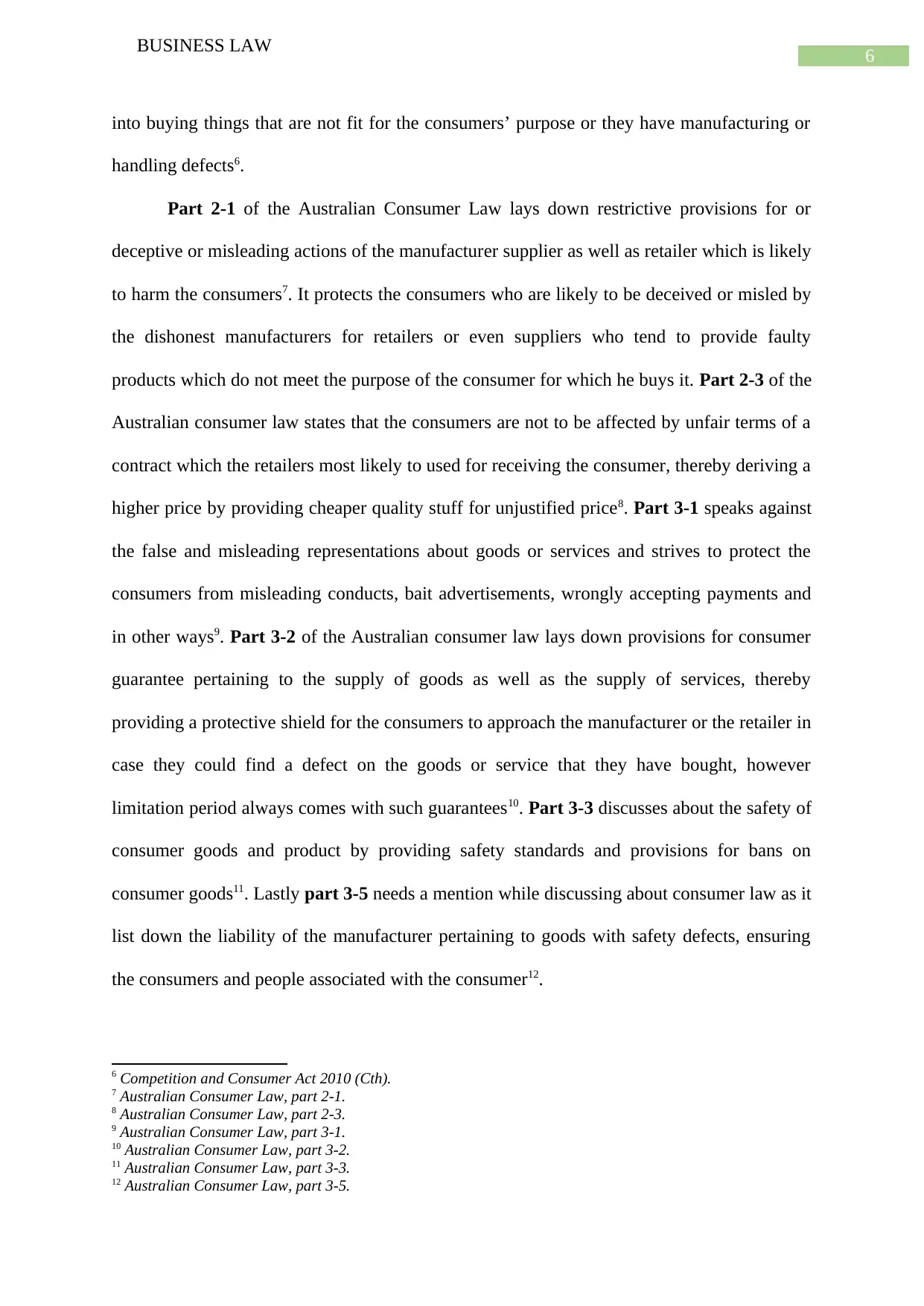
6
BUSINESS LAW
into buying things that are not fit for the consumers’ purpose or they have manufacturing or
handling defects6.
Part 2-1 of the Australian Consumer Law lays down restrictive provisions for or
deceptive or misleading actions of the manufacturer supplier as well as retailer which is likely
to harm the consumers7. It protects the consumers who are likely to be deceived or misled by
the dishonest manufacturers for retailers or even suppliers who tend to provide faulty
products which do not meet the purpose of the consumer for which he buys it. Part 2-3 of the
Australian consumer law states that the consumers are not to be affected by unfair terms of a
contract which the retailers most likely to used for receiving the consumer, thereby deriving a
higher price by providing cheaper quality stuff for unjustified price8. Part 3-1 speaks against
the false and misleading representations about goods or services and strives to protect the
consumers from misleading conducts, bait advertisements, wrongly accepting payments and
in other ways9. Part 3-2 of the Australian consumer law lays down provisions for consumer
guarantee pertaining to the supply of goods as well as the supply of services, thereby
providing a protective shield for the consumers to approach the manufacturer or the retailer in
case they could find a defect on the goods or service that they have bought, however
limitation period always comes with such guarantees10. Part 3-3 discusses about the safety of
consumer goods and product by providing safety standards and provisions for bans on
consumer goods11. Lastly part 3-5 needs a mention while discussing about consumer law as it
list down the liability of the manufacturer pertaining to goods with safety defects, ensuring
the consumers and people associated with the consumer12.
6 Competition and Consumer Act 2010 (Cth).
7 Australian Consumer Law, part 2-1.
8 Australian Consumer Law, part 2-3.
9 Australian Consumer Law, part 3-1.
10 Australian Consumer Law, part 3-2.
11 Australian Consumer Law, part 3-3.
12 Australian Consumer Law, part 3-5.
BUSINESS LAW
into buying things that are not fit for the consumers’ purpose or they have manufacturing or
handling defects6.
Part 2-1 of the Australian Consumer Law lays down restrictive provisions for or
deceptive or misleading actions of the manufacturer supplier as well as retailer which is likely
to harm the consumers7. It protects the consumers who are likely to be deceived or misled by
the dishonest manufacturers for retailers or even suppliers who tend to provide faulty
products which do not meet the purpose of the consumer for which he buys it. Part 2-3 of the
Australian consumer law states that the consumers are not to be affected by unfair terms of a
contract which the retailers most likely to used for receiving the consumer, thereby deriving a
higher price by providing cheaper quality stuff for unjustified price8. Part 3-1 speaks against
the false and misleading representations about goods or services and strives to protect the
consumers from misleading conducts, bait advertisements, wrongly accepting payments and
in other ways9. Part 3-2 of the Australian consumer law lays down provisions for consumer
guarantee pertaining to the supply of goods as well as the supply of services, thereby
providing a protective shield for the consumers to approach the manufacturer or the retailer in
case they could find a defect on the goods or service that they have bought, however
limitation period always comes with such guarantees10. Part 3-3 discusses about the safety of
consumer goods and product by providing safety standards and provisions for bans on
consumer goods11. Lastly part 3-5 needs a mention while discussing about consumer law as it
list down the liability of the manufacturer pertaining to goods with safety defects, ensuring
the consumers and people associated with the consumer12.
6 Competition and Consumer Act 2010 (Cth).
7 Australian Consumer Law, part 2-1.
8 Australian Consumer Law, part 2-3.
9 Australian Consumer Law, part 3-1.
10 Australian Consumer Law, part 3-2.
11 Australian Consumer Law, part 3-3.
12 Australian Consumer Law, part 3-5.
Paraphrase This Document
Need a fresh take? Get an instant paraphrase of this document with our AI Paraphraser
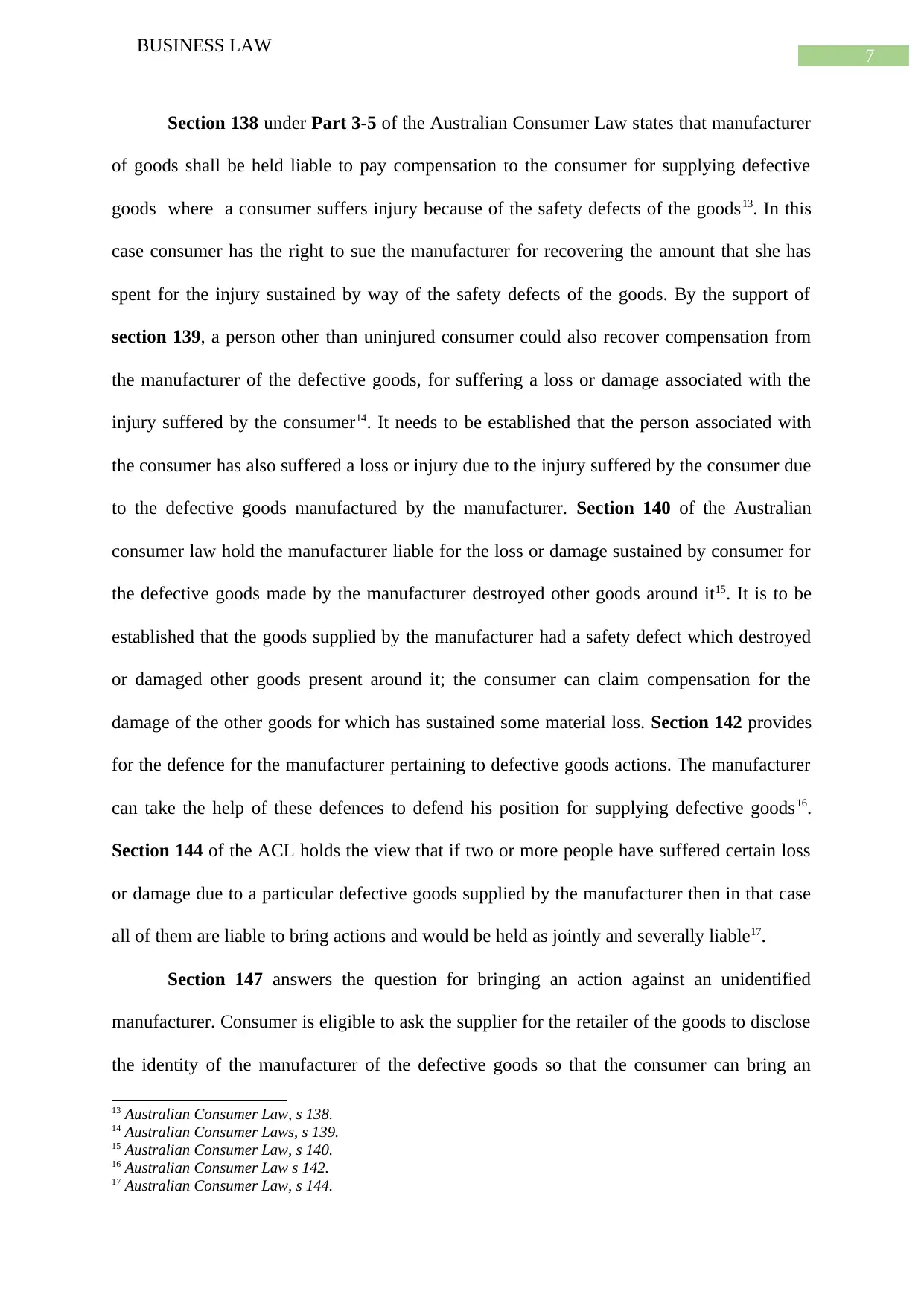
7
BUSINESS LAW
Section 138 under Part 3-5 of the Australian Consumer Law states that manufacturer
of goods shall be held liable to pay compensation to the consumer for supplying defective
goods where a consumer suffers injury because of the safety defects of the goods13. In this
case consumer has the right to sue the manufacturer for recovering the amount that she has
spent for the injury sustained by way of the safety defects of the goods. By the support of
section 139, a person other than uninjured consumer could also recover compensation from
the manufacturer of the defective goods, for suffering a loss or damage associated with the
injury suffered by the consumer14. It needs to be established that the person associated with
the consumer has also suffered a loss or injury due to the injury suffered by the consumer due
to the defective goods manufactured by the manufacturer. Section 140 of the Australian
consumer law hold the manufacturer liable for the loss or damage sustained by consumer for
the defective goods made by the manufacturer destroyed other goods around it15. It is to be
established that the goods supplied by the manufacturer had a safety defect which destroyed
or damaged other goods present around it; the consumer can claim compensation for the
damage of the other goods for which has sustained some material loss. Section 142 provides
for the defence for the manufacturer pertaining to defective goods actions. The manufacturer
can take the help of these defences to defend his position for supplying defective goods16.
Section 144 of the ACL holds the view that if two or more people have suffered certain loss
or damage due to a particular defective goods supplied by the manufacturer then in that case
all of them are liable to bring actions and would be held as jointly and severally liable17.
Section 147 answers the question for bringing an action against an unidentified
manufacturer. Consumer is eligible to ask the supplier for the retailer of the goods to disclose
the identity of the manufacturer of the defective goods so that the consumer can bring an
13 Australian Consumer Law, s 138.
14 Australian Consumer Laws, s 139.
15 Australian Consumer Law, s 140.
16 Australian Consumer Law s 142.
17 Australian Consumer Law, s 144.
BUSINESS LAW
Section 138 under Part 3-5 of the Australian Consumer Law states that manufacturer
of goods shall be held liable to pay compensation to the consumer for supplying defective
goods where a consumer suffers injury because of the safety defects of the goods13. In this
case consumer has the right to sue the manufacturer for recovering the amount that she has
spent for the injury sustained by way of the safety defects of the goods. By the support of
section 139, a person other than uninjured consumer could also recover compensation from
the manufacturer of the defective goods, for suffering a loss or damage associated with the
injury suffered by the consumer14. It needs to be established that the person associated with
the consumer has also suffered a loss or injury due to the injury suffered by the consumer due
to the defective goods manufactured by the manufacturer. Section 140 of the Australian
consumer law hold the manufacturer liable for the loss or damage sustained by consumer for
the defective goods made by the manufacturer destroyed other goods around it15. It is to be
established that the goods supplied by the manufacturer had a safety defect which destroyed
or damaged other goods present around it; the consumer can claim compensation for the
damage of the other goods for which has sustained some material loss. Section 142 provides
for the defence for the manufacturer pertaining to defective goods actions. The manufacturer
can take the help of these defences to defend his position for supplying defective goods16.
Section 144 of the ACL holds the view that if two or more people have suffered certain loss
or damage due to a particular defective goods supplied by the manufacturer then in that case
all of them are liable to bring actions and would be held as jointly and severally liable17.
Section 147 answers the question for bringing an action against an unidentified
manufacturer. Consumer is eligible to ask the supplier for the retailer of the goods to disclose
the identity of the manufacturer of the defective goods so that the consumer can bring an
13 Australian Consumer Law, s 138.
14 Australian Consumer Laws, s 139.
15 Australian Consumer Law, s 140.
16 Australian Consumer Law s 142.
17 Australian Consumer Law, s 144.
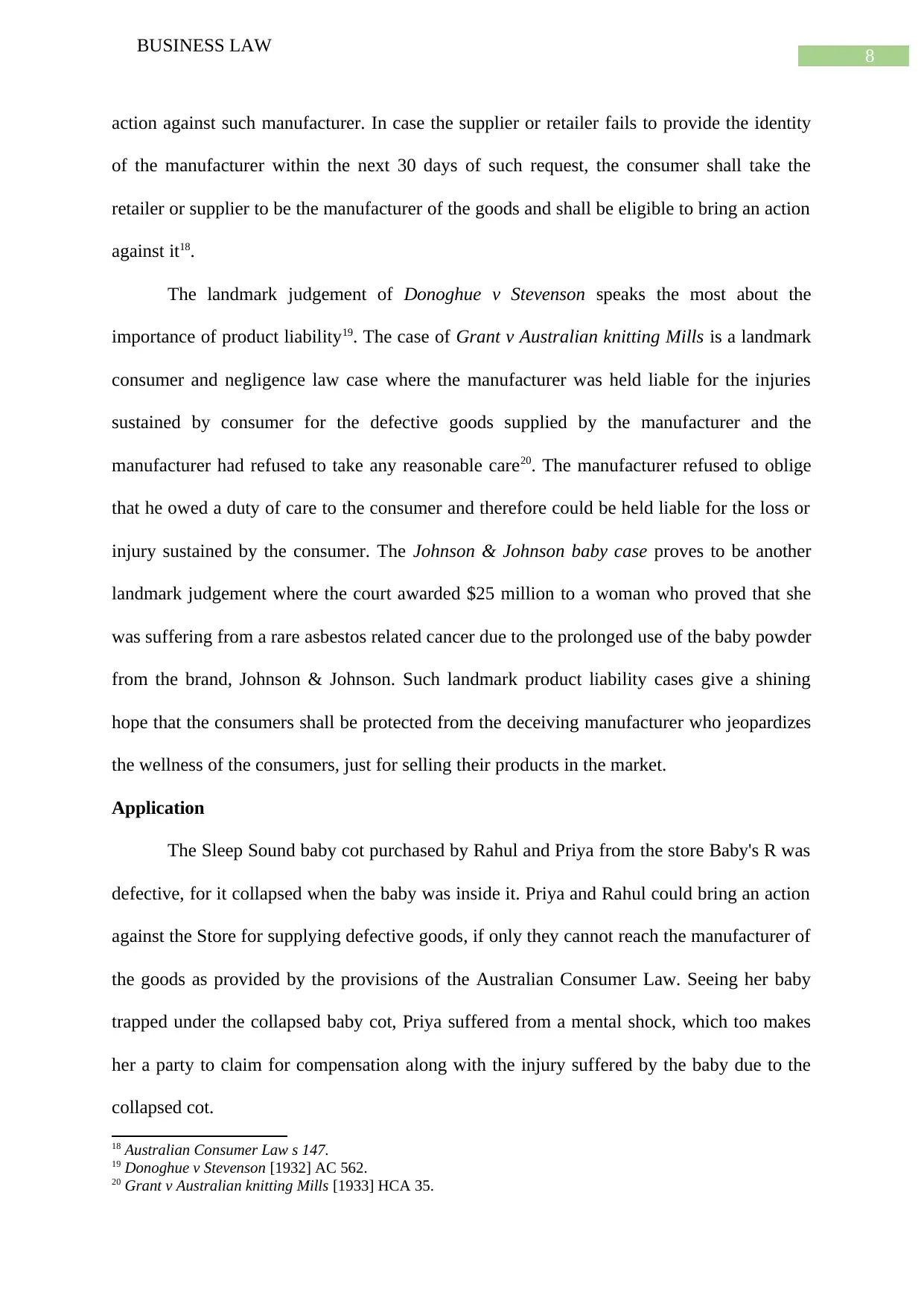
8
BUSINESS LAW
action against such manufacturer. In case the supplier or retailer fails to provide the identity
of the manufacturer within the next 30 days of such request, the consumer shall take the
retailer or supplier to be the manufacturer of the goods and shall be eligible to bring an action
against it18.
The landmark judgement of Donoghue v Stevenson speaks the most about the
importance of product liability19. The case of Grant v Australian knitting Mills is a landmark
consumer and negligence law case where the manufacturer was held liable for the injuries
sustained by consumer for the defective goods supplied by the manufacturer and the
manufacturer had refused to take any reasonable care20. The manufacturer refused to oblige
that he owed a duty of care to the consumer and therefore could be held liable for the loss or
injury sustained by the consumer. The Johnson & Johnson baby case proves to be another
landmark judgement where the court awarded $25 million to a woman who proved that she
was suffering from a rare asbestos related cancer due to the prolonged use of the baby powder
from the brand, Johnson & Johnson. Such landmark product liability cases give a shining
hope that the consumers shall be protected from the deceiving manufacturer who jeopardizes
the wellness of the consumers, just for selling their products in the market.
Application
The Sleep Sound baby cot purchased by Rahul and Priya from the store Baby's R was
defective, for it collapsed when the baby was inside it. Priya and Rahul could bring an action
against the Store for supplying defective goods, if only they cannot reach the manufacturer of
the goods as provided by the provisions of the Australian Consumer Law. Seeing her baby
trapped under the collapsed baby cot, Priya suffered from a mental shock, which too makes
her a party to claim for compensation along with the injury suffered by the baby due to the
collapsed cot.
18 Australian Consumer Law s 147.
19 Donoghue v Stevenson [1932] AC 562.
20 Grant v Australian knitting Mills [1933] HCA 35.
BUSINESS LAW
action against such manufacturer. In case the supplier or retailer fails to provide the identity
of the manufacturer within the next 30 days of such request, the consumer shall take the
retailer or supplier to be the manufacturer of the goods and shall be eligible to bring an action
against it18.
The landmark judgement of Donoghue v Stevenson speaks the most about the
importance of product liability19. The case of Grant v Australian knitting Mills is a landmark
consumer and negligence law case where the manufacturer was held liable for the injuries
sustained by consumer for the defective goods supplied by the manufacturer and the
manufacturer had refused to take any reasonable care20. The manufacturer refused to oblige
that he owed a duty of care to the consumer and therefore could be held liable for the loss or
injury sustained by the consumer. The Johnson & Johnson baby case proves to be another
landmark judgement where the court awarded $25 million to a woman who proved that she
was suffering from a rare asbestos related cancer due to the prolonged use of the baby powder
from the brand, Johnson & Johnson. Such landmark product liability cases give a shining
hope that the consumers shall be protected from the deceiving manufacturer who jeopardizes
the wellness of the consumers, just for selling their products in the market.
Application
The Sleep Sound baby cot purchased by Rahul and Priya from the store Baby's R was
defective, for it collapsed when the baby was inside it. Priya and Rahul could bring an action
against the Store for supplying defective goods, if only they cannot reach the manufacturer of
the goods as provided by the provisions of the Australian Consumer Law. Seeing her baby
trapped under the collapsed baby cot, Priya suffered from a mental shock, which too makes
her a party to claim for compensation along with the injury suffered by the baby due to the
collapsed cot.
18 Australian Consumer Law s 147.
19 Donoghue v Stevenson [1932] AC 562.
20 Grant v Australian knitting Mills [1933] HCA 35.
⊘ This is a preview!⊘
Do you want full access?
Subscribe today to unlock all pages.

Trusted by 1+ million students worldwide
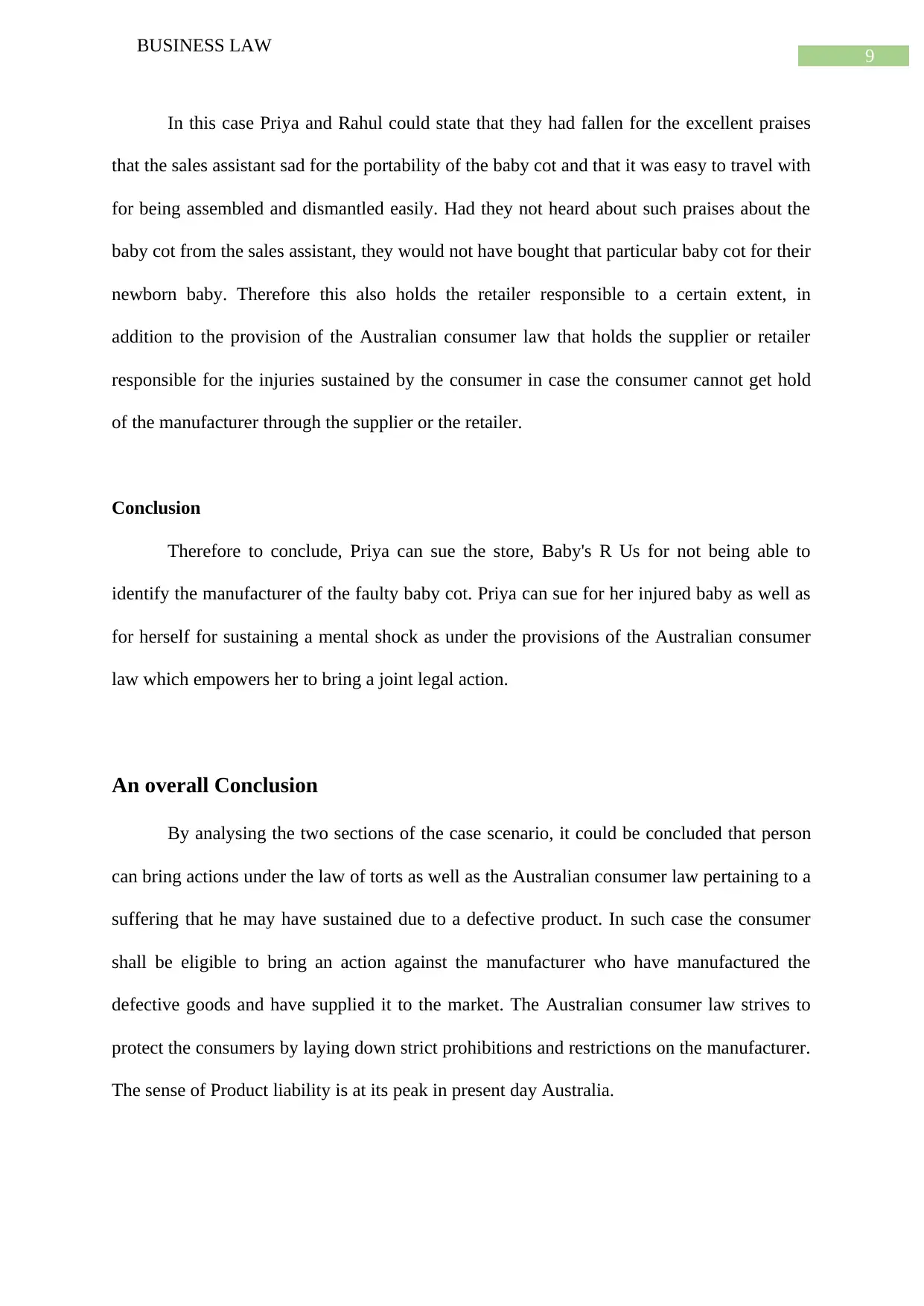
9
BUSINESS LAW
In this case Priya and Rahul could state that they had fallen for the excellent praises
that the sales assistant sad for the portability of the baby cot and that it was easy to travel with
for being assembled and dismantled easily. Had they not heard about such praises about the
baby cot from the sales assistant, they would not have bought that particular baby cot for their
newborn baby. Therefore this also holds the retailer responsible to a certain extent, in
addition to the provision of the Australian consumer law that holds the supplier or retailer
responsible for the injuries sustained by the consumer in case the consumer cannot get hold
of the manufacturer through the supplier or the retailer.
Conclusion
Therefore to conclude, Priya can sue the store, Baby's R Us for not being able to
identify the manufacturer of the faulty baby cot. Priya can sue for her injured baby as well as
for herself for sustaining a mental shock as under the provisions of the Australian consumer
law which empowers her to bring a joint legal action.
An overall Conclusion
By analysing the two sections of the case scenario, it could be concluded that person
can bring actions under the law of torts as well as the Australian consumer law pertaining to a
suffering that he may have sustained due to a defective product. In such case the consumer
shall be eligible to bring an action against the manufacturer who have manufactured the
defective goods and have supplied it to the market. The Australian consumer law strives to
protect the consumers by laying down strict prohibitions and restrictions on the manufacturer.
The sense of Product liability is at its peak in present day Australia.
BUSINESS LAW
In this case Priya and Rahul could state that they had fallen for the excellent praises
that the sales assistant sad for the portability of the baby cot and that it was easy to travel with
for being assembled and dismantled easily. Had they not heard about such praises about the
baby cot from the sales assistant, they would not have bought that particular baby cot for their
newborn baby. Therefore this also holds the retailer responsible to a certain extent, in
addition to the provision of the Australian consumer law that holds the supplier or retailer
responsible for the injuries sustained by the consumer in case the consumer cannot get hold
of the manufacturer through the supplier or the retailer.
Conclusion
Therefore to conclude, Priya can sue the store, Baby's R Us for not being able to
identify the manufacturer of the faulty baby cot. Priya can sue for her injured baby as well as
for herself for sustaining a mental shock as under the provisions of the Australian consumer
law which empowers her to bring a joint legal action.
An overall Conclusion
By analysing the two sections of the case scenario, it could be concluded that person
can bring actions under the law of torts as well as the Australian consumer law pertaining to a
suffering that he may have sustained due to a defective product. In such case the consumer
shall be eligible to bring an action against the manufacturer who have manufactured the
defective goods and have supplied it to the market. The Australian consumer law strives to
protect the consumers by laying down strict prohibitions and restrictions on the manufacturer.
The sense of Product liability is at its peak in present day Australia.
Paraphrase This Document
Need a fresh take? Get an instant paraphrase of this document with our AI Paraphraser
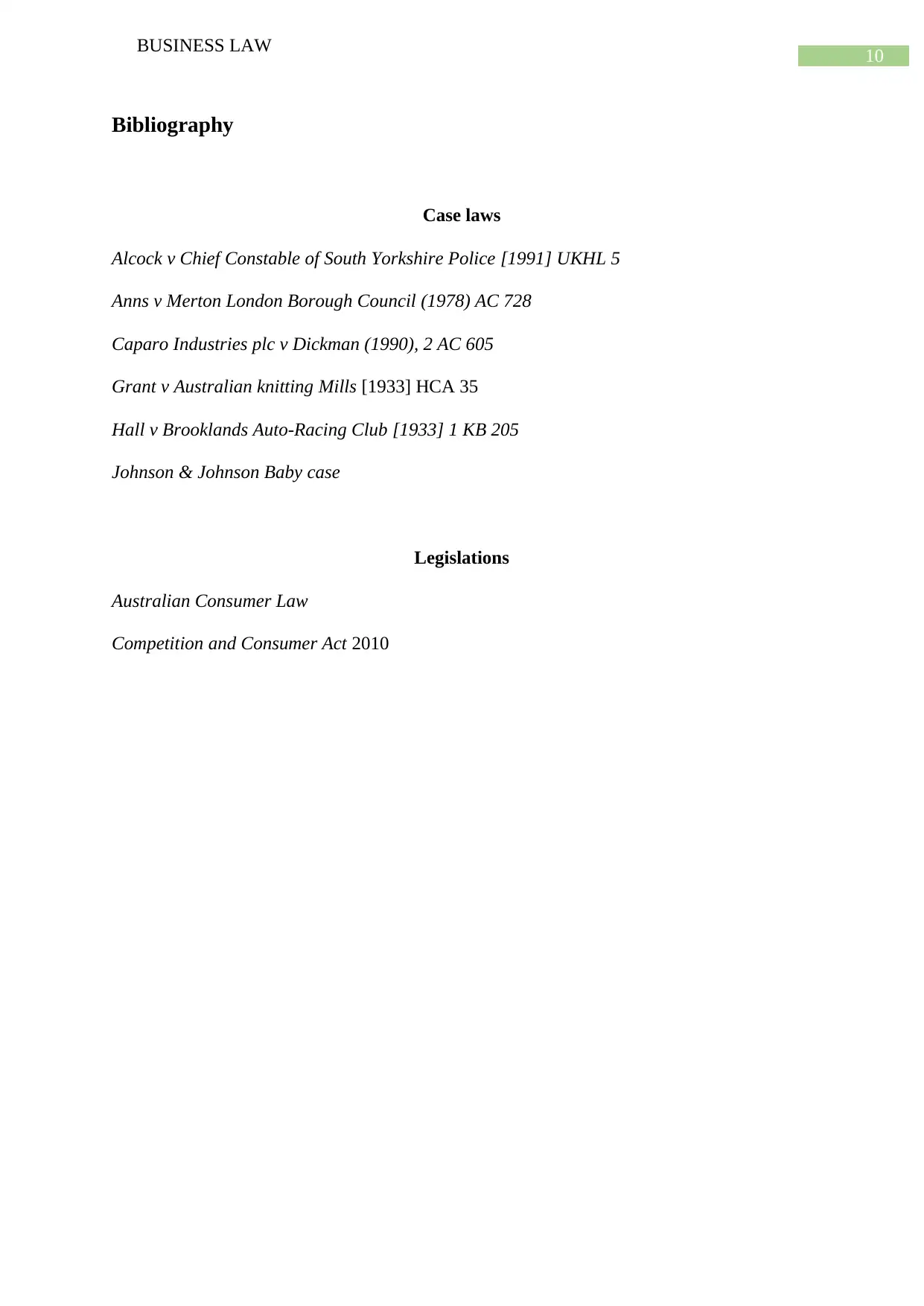
10
BUSINESS LAW
Bibliography
Case laws
Alcock v Chief Constable of South Yorkshire Police [1991] UKHL 5
Anns v Merton London Borough Council (1978) AC 728
Caparo Industries plc v Dickman (1990), 2 AC 605
Grant v Australian knitting Mills [1933] HCA 35
Hall v Brooklands Auto-Racing Club [1933] 1 KB 205
Johnson & Johnson Baby case
Legislations
Australian Consumer Law
Competition and Consumer Act 2010
BUSINESS LAW
Bibliography
Case laws
Alcock v Chief Constable of South Yorkshire Police [1991] UKHL 5
Anns v Merton London Borough Council (1978) AC 728
Caparo Industries plc v Dickman (1990), 2 AC 605
Grant v Australian knitting Mills [1933] HCA 35
Hall v Brooklands Auto-Racing Club [1933] 1 KB 205
Johnson & Johnson Baby case
Legislations
Australian Consumer Law
Competition and Consumer Act 2010
1 out of 11
Related Documents
Your All-in-One AI-Powered Toolkit for Academic Success.
+13062052269
info@desklib.com
Available 24*7 on WhatsApp / Email
![[object Object]](/_next/static/media/star-bottom.7253800d.svg)
Unlock your academic potential
Copyright © 2020–2025 A2Z Services. All Rights Reserved. Developed and managed by ZUCOL.





